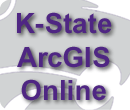K-State Curriculum and Training
About GIS
GIS (Geographic Information Systems) is both an exciting and rapidly developing technology that is used extensively throughout all levels of government, the private sector, and academia to provide support for spatial decision-making and problem solving. Underscoring the importance and value of GIS, and other geospatial technologies such as remote sensing and global positioning systems (GPS), the U.S. Department of Labor (2004) identified “geospatial technology” as one of the three most important science and technology employment areas, along with biotechnology and nanotechnology.
University Degree Programs
B.S., Geographic Information Science & Technology (GIST)
Geographic Information Science (GIScience) is the field that underpins the wise use of geospatial technologies and methods, including geographic information systems (GIS), acquisition and analysis of remotely-sensed imagery, cartography and mapping, and quantitative spatial analysis and modelling. Collectively, this knowledge and skills area is referred to as Geographic Information Science and Technology (GIS&T).
This interdisciplinary degree program is composed of equal parts computer science and geography/geographic techniques and affords students the opportunity to specialize in a variety of application areas via free electives to customize their educational program. This design also provides students with the ability to earn additional academic credentials (e.g., double-major, minors, certificates) at little/no cost that are in line with interests and career plans, whether that is immediate workforce entry or further graduate-level education.
University Courses
Students in nearly every discipline stand to benefit from the use of GIS, and a greater understanding of GIScience, in the conduct of basic and applied science. Kansas State University offers a number of introductory, intermediate, and advanced courses in geographic information science. Most of theses courses (listed below) can be used to fulfill the requirements of two very popular interdiscplinary certificate programs - the Undergraduate Certificate in GIS and the Graduate Certificate in GIScience. Be sure to consult the Undergraduate (700-level and below) or Graduate (500-level and above) Catalogs to review any prerequisite course requirements.
Esri Training Opportunities
For those interested in focused hands-on tutorials designed to introduce basic GIS software skills, Esri makes available a number of Web-based short courses through their Esri Training site. The Esri Software and Resources link will direct you to a page with more information about requesting access to Esri Training, as well as an outline of other resources available to Kansas State University faculty, staff, and students.

